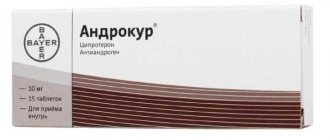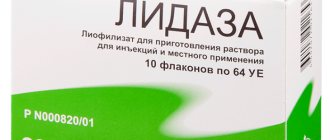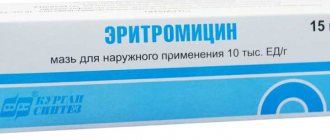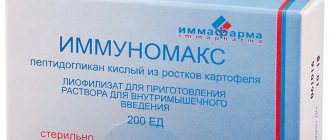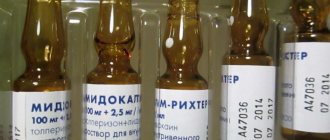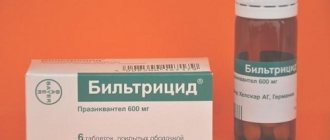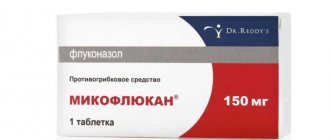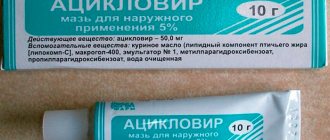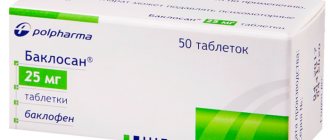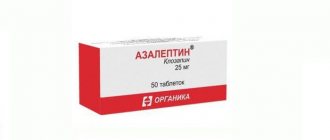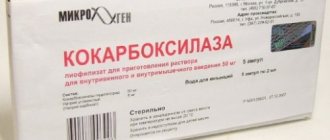1834
Author of the article
Evgeniy Nikolaevich Konoplev
Reading time: 6 minutes
AA
Kanamycin is a broad-spectrum antibiotic from the aminoglycoside group. It has a bactericidal effect on most harmful microorganisms that cause various infectious diseases. The drug is available with a doctor's prescription and can be purchased at any pharmacy. It is relatively inexpensive, which makes it possible for even people with limited financial resources to take the medicine.
Pharmacodynamics and pharmacokinetics
The principle of action is based on damage to the cell membrane of the microorganism, blocking the production of proteins, and disrupting the process of formation of the matrix and transfer RNA complex.
The main substance penetrates into the cell of the microorganism and binds to special receptor proteins. Kanamycin affects gram-negative flora, gram-positive bacteria, Proteus, staphylococci, Neisseria, Shigella, Escherichia coli, Klebsiella, Salmonella. Strains of these microorganisms do not respond to the action of erythromycin, tetracycline, chloramphenicol , streptomycin, benzylpenicillin.
The drug does not affect protozoa, yeast fungi, anaerobic flora, viruses, streptococci.
Pharmacological properties of the drug Kanamycin
Pharmacodynamics . Kanamycin is a broad-spectrum antibiotic. It has a bactericidal effect on most gram-positive and gram-negative microorganisms, as well as acid-fast bacteria. Acts on strains of Mycobacterium tuberculosis, including those resistant to streptomycin, PAS, and isoniazid. By binding to the 30S subunit of the ribosomal membrane, it inhibits protein synthesis in the microbial cell. Effective, as a rule, against microorganisms resistant to tetracycline, erythromycin, and chloramphenicol. Does not affect anaerobic microorganisms, yeast, viruses and most protozoa. Pharmacokinetics. When administered intramuscularly, it quickly enters the blood, the therapeutic concentration is maintained for 8–12 hours. Penetrates into the pleural cavity, synovial fluid, bronchial secretions, bile, and through the placental barrier. Normally, kanamycin does not penetrate the BBB, but with inflammation of the meninges, its concentration in the CSF reaches 30–60% of that in the blood plasma. Excreted by the kidneys within 24–48 hours.
Indications for use
Kanamycin is prescribed for various infectious diseases. For pleural empyema, pneumonia, tuberculosis , infected burns, infections of the biliary tract, nervous system, respiratory system, abdominal cavity, joints, bones, for cystitis, pyelitis, pyelonephritis and other infectious lesions of the urinary system, as well as for sepsis and after surgical interventions, medication administered parenterally.
Tablet forms of the drug are indicated for hepatic coma, enterocolitis , dysentery bacteria carriage, dysentery , intestinal infections, and before operations on the digestive tract.
Kanamycin eye films are used for ulcerative lesions of the cornea, blepharitis , bacterial conjunctivitis, and keratitis .
Treatment of peritonitis with a strong antibiotic
This is a bacterial disease that develops in the abdominal cavity. Peritonitis is an inflammation of the serous membrane of the peritoneum. The main cause of this disease is infection. Other factors for the appearance of this disease may be:
- Abdominal injuries.
— Pathology of the intestines and bile ducts.
- Inflammation of the ovaries.
- Perforation of a stomach ulcer.
Mortality with a diagnosis such as peritonitis is high, so the problem of treating this disease is relevant. Treatment of a disease begins with eliminating the cause of its occurrence. Therefore, surgical intervention in this case is necessary. At the same time, drug treatment is carried out, in which the main role is played by the drug “Kanamycin”. It corrects all those disorders that developed during peritonitis.
Why is this medication prescribed? The fact is that most often the cause of peritonitis is a microbial composition of several organisms. Therefore, it is advisable to prescribe broad-spectrum antibiotics, which includes Kanamycin powder.
For moderate problems, this drug is prescribed intravenously. In severe cases, treatment of peritonitis with the drug "Kanamycin" is carried out intravenously. This method can also be used in cases of septic shock.
Side effects
Digestive tract: flatulence, diarrhea, oily stool, foamy stool, diarrhea, malabsorption syndrome, increased levels of liver enzymes, vomiting, nausea.
Hematopoietic organs: thrombocytopenia , leukopenia, anemia, granulocytopenia.
Nervous system: the neurotoxic effect manifests itself in epileptic seizures, paresthesia, tingling, numbness, muscle twitching , weakness, drowsiness, headaches, respiratory arrest due to disruption of neuromuscular transmission.
Sense organs: Kanamycin has an ototoxic effect, which is manifested by decreased hearing to deafness, congestion in the ears, and ringing. The drug affects the vestibular apparatus, causing vomiting, nausea, dizziness, and incoordination of movements .
Urinary system: nephrotoxicity, albuminuria, microhematuria, cylinduria, thirst , increased frequency of urination.
Possible development of angioedema , fever, itching, skin rash.
The use of eye films causes a foreign body sensation in the eye for several minutes and can cause eyelid hyperemia, swelling and lacrimation.
Analogues briefly
Analogues of Amikacin are:
- Selemicin. The active ingredient is amikacin. Available in the form of an injection solution. Can be prescribed for otitis media.
- Gentamicin (solution for injection). The drug is a 2nd generation aminoglycoside. Acts bactericidal. Can be prescribed for ventriculitis (inflammation of the ventricles of the heart), pyoderma and eye diseases (for drops and ointments).
- Netilmicin Protech. The active ingredient is netilmicin. The drug is a 3rd generation aminoglycoside. Contraindicated in children under 3 years of age.
- Amikacin-Ferein (solution, powder and lyophilisate). Indications are similar to Amikacin.
Instead of Amikacin, antibiotics of other groups (cephalosporins, fluoroquinolones) may be prescribed.
Kanamycin, instructions for use (Method and dosage)
Administered by injection intramuscularly or intravenously.
According to the instructions for use of Kanamycin, a single dosage for intravenous drip infusion is 0.5 grams, diluted in 200 ml of 5% dextrose solution, the rate of administration is 60-80 drops per minute.
For infectious lesions of non-tuberculosis etiology, the antibiotic is administered in a single dose of 0.5 grams, no more than 2 grams per day. The duration of antimicrobial therapy is 5-7 days.
For tuberculosis, Kanamycin is administered intramuscularly once a day, one gram, or the dose is divided into 2 doses of 0.5 grams. In the preoperative period, for the purpose of intestinal sanitation, adults are prescribed an antibiotic of 0.75 grams every 5 hours, no more than 4 grams per day.
Hepatic encephalopathy: 2-3 grams orally every 6 hours.
A 0.25% solution in an amount of 10-50 ml is injected into the articular, pleural, and abdominal cavities for washing.
To carry out peritoneal dialysis, 1-2 grams of kanamycin are dissolved in 500 ml of dialysate fluid.
Aerosol inhalations can be carried out with an injection solution 2-4 times a day, 250 mg.
It is administered intraperitoneally as a 2.5% solution of 500 mg.
The eye film is removed from the bottle or pencil case using sterile ophthalmic tweezers, the lower eyelid is pulled back with your fingers and the film is placed in the space between the eyeball and the eyelid, after which the eyelid is lowered, holding the eye in a stationary, calm state for a minute to wet the eye film and subsequent transition it into a soft, elastic state.
Eye films are used up to two times daily.
Basic information
Before you start taking Kanamycin, you should consult your doctor. Only he will be able to select the correct dosage and determine the duration of treatment. Otherwise, you can not only worsen your health, but also get complications.
Release form and composition
Manufacturers of the drug Kanamycin produce it only in one dosage form - powder for preparing a solution. The finished mixture can be administered intravenously or intramuscularly, which allows doctors to choose the most suitable option for the patient.
The powder can be bought at almost any pharmacy. It is sold in 10 ml bottles. These containers are combined into cardboard packages of 5, 10 or 50 pieces. The box must contain instructions for using the drug. Kanamycin is not produced in tablet form.
The composition of the drug does not differ in the large number of components. It includes the following substances:
- Kanamycin sulfate is the active ingredient, which is contained in an amount of 0.5 or 1 g.
- distilled water for preparing the solution (2 or 5 ml).
Before administration, both components are thoroughly mixed until the powder is completely dissolved in water.
Indications
Kanamycin is used to treat a wide range of diseases. It is often prescribed for those patients who need a fast-acting medicine.
The main diseases that can be cured with Kanamycin:
- infectious and inflammatory diseases of the respiratory system - pneumonia, pleural empyema, lung abscess;
- purulent complications that arise after serious injuries, or problems in the postoperative period;
- peritonitis, sepsis, meningitis, septic endocarditis and other serious purulent-septic diseases;
- diseases of the kidneys and urinary tract - pyelonephritis, cystitis, urethritis, etc.;
- pulmonary tuberculosis;
- pathologies caused by tuberculosis bacteria;
- infection after burns and other damage to the skin surface.
Contraindications
In some cases, it is prohibited to use Kanamycin for medicinal purposes, since it can only worsen the existing disease. The manufacturers of the drug have compiled a list of contraindications that must be taken into account before starting a course of treatment.
Among the main contraindications are the following:
- severe form of chronic renal failure, accompanied by uremia (poisoning with substances that are not excreted from the body) and azotemia (increased levels of nitrogenous metabolic products in the blood);
- neuritis of cranial nerves;
- the entire period of pregnancy;
- individual intolerance to the active substance of the drug;
- allergic reaction caused by Kanamycin analogues.
Sometimes the drug is prescribed with caution. At the same time, it is important not only to clearly calculate the dose, but also to constantly monitor changes in health status. Such cases include:
- lactation period;
- elderly age;
- age up to 1 month;
- premature babies;
- parkinsonism, myasthenia gravis, botulism;
- renal failure.
Overdose
It manifests itself as toxic reactions in the form of thirst, decreased appetite, ataxia , hearing loss, dizziness, decreased appetite, respiratory failure, congestion in the ears, ringing in the ears, nausea.
Hemodialysis is carried out to relieve the blockade of neuromuscular transmission and eliminate its consequences.
The administration of calcium salts, anticholinesterase drugs , and the use of peritoneal dialysis .
Contraindications
- Neuritis of the VIII pair of cranial nerves;
- Severe chronic renal failure with azotemia and uremia;
- Pregnancy;
- Hypersensitivity to the components of the drug (including a history of other aminoglycosides).
Kanamycin should be administered with caution to nursing women, elderly patients, premature infants and children younger than 1 month, as well as patients with myasthenia gravis, parkinsonism, renal failure and botulism (aminoglycosides can lead to disruption of neuromuscular transmission, which will cause further weakening of skeletal muscles).
Interaction
Kanamycin enhances the muscle relaxant effect of polymyxin , general anesthetics , curare-like drugs, and reduces the effectiveness of antimyasthenic drugs .
with gentamicin , streptomycin, heparin, penicillin, viomycin, nitrofurantoin , erythromycin, amphotericin B, capreomycin, and cephalosporins.
Cephalosporins , penicillins and other beta-lactam antibiotics can reduce the effectiveness of the aminoglycoside in patients with severe chronic renal failure.
Vancomycin , cisplatin , polymyxin, nalidixic acid increase the likelihood of nephrotoxicity and ototoxicity .
NSAIDs, sulfonamides, penicillins, cephalosporins, diuretics, especially furosemide, increase neurotoxicity and nephrotoxicity by blocking the elimination of aminoglycosides when competing for active secretion in the nephron tubules, which ultimately leads to an increase in their concentration in the blood serum.
When an antibiotic is administered intraperitoneally, the risk of developing apnea increases significantly with simultaneous intake of cyclopropane .
Parenteral administration of indomethacin increases the likelihood of toxic effects of aminoglycosides by reducing clearance and prolonging the half-life.
Respiratory arrest and nephrotoxicity are observed with the administration of polymyxins, methoxyflurane, and narcotic analgesics .
Patient reviews
Eugene. The antibiotic Kanamycin helped me cope with meningitis. I was injected with it for several weeks, and it gave a positive result. The disease gradually subsided, and I felt much better every day.
Pauline. I was given Kanamycin injections during treatment for pneumonia. The drug showed its best side and allowed me to quickly recover. I didn't experience any side effects. I am very pleased with the effectiveness of the medicine and am grateful to the doctor who prescribed it to me.
Alexander. While on vacation I picked up a skin infection. I went to a medical facility and an experienced doctor advised me to undergo a course of treatment with Kanamycin. I was given intramuscular injections and my condition gradually improved. As a result, I completely got rid of the disease and returned to normal life.
© 2021 – 2021, Evgeniy Nikolaevich Konoplev. All rights reserved.
special instructions
The risk of developing nephrotoxicity increases significantly in patients with severe pathology of the renal system.
During the period of antimicrobial therapy, monitoring the condition of the vestibular apparatus, auditory nerve , and the functioning of the renal system is mandatory. If unsatisfactory results of audiometric tests are registered, the drug is discontinued or its dosage is reduced.
Aminoglycosides are capable of passing into breast milk in small quantities, but complications in infants have not been reported due to poor absorption of the drug from the digestive tract.
Patients with inflammatory and infectious lesions of the urinary tract need to drink more fluids during the treatment period.
The development of bacterial resistance may be indicated by the lack of positive dynamics, which requires a change in the antibacterial agent.
Infusions of undiluted kanamycin are not recommended due to the risk of developing neuromuscular blockade .
In hepatic coma, Kanamycin is used for a long time to suppress the bacterial intestinal flora to reduce ammonia intoxication.
Release forms
Varieties of the drug are used in therapy:
- Tablets are made on the basis of kanamycin monosulfate - a white, tasteless powder, easily soluble in water (not in alcohols and alkalis).
- The substance of kanamycin sulfate should be diluted with a sterile solvent for injections and droppers.
They are produced in bottles of 0.5 and 1 g of the substance for injection. The ampoule form of release of 5-10 ml includes 0.25 and 0.5 g of the drug. Tablets contain 0.125 and 0.25 g of kanamycin monosulfate.
Antiseptic sponge with kanamycin contains 37500 IU of active substance, 1.5 mg of nitrofural. Used for burns, injuries, bleeding, trophic ulcers, post-surgical complications.
Storage rules
The powder must be stored in a dry and dark place, away from the sun. The normal storage temperature for the medicine is up to 20 degrees. It is strictly forbidden to store the drug in a place accessible to children. After all, the product has no protection from children’s hands. Therefore, parents should be careful about where they put medications.
When diluting the powder, the prepared solution should be used immediately. It is prohibited to store the finished drug in liquid form.
The shelf life of the medicine is 3 years.
Positive evaluations from people
This drug receives varying reviews. Some people like it and others don't. Those patients who have found the remedy suitable note that before using it, you need to read a document such as instructions for use. “Kanamycin” is an antibiotic that has repeatedly shown itself to be positive in the treatment of tuberculosis and peritonitis. People often write that they used this drug to treat pleurisy, severe bronchitis, and pneumonia. That is, this medicine can also be used for colds, but only when the disease has already affected the internal organs. Judging by the reviews, the drug acts quickly: already on the second day after the injection, a person feels much better. And in another week he is ready to be discharged from the hospital.
Also, many note that the injection is not particularly painful. But this is an antibiotic.
The drug is really good, but do not forget that in no case should you self-medicate.
